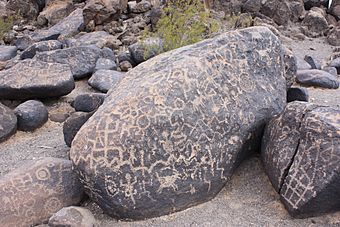Painted Rock Petroglyph Site facts for kids
Quick facts for kids |
|
|
Painted Rock Petroglyph Site
|
|
 |
|
| Nearest city | Theba, Arizona |
|---|---|
| Architectural style | Petroglyphs |
| NRHP reference No. | 77000238 |
| Added to NRHP | November 25, 1977 |
The Painted Rock Petroglyph Site is a special place in Arizona where you can see hundreds of ancient rock carvings. These carvings, called petroglyphs, were made long ago near the town of Theba. The site was added to the National Register of Historic Places in 1977. Today, the Bureau of Land Management (BLM) takes care of it. They have a campground and a walking trail where you can explore and learn about the petroglyphs.
Before 1989, this site was part of Painted Rock State Park. It even had camping spots near the Painted Rock Reservoir. But in 1989, the state gave control to the BLM. The reservoir area was closed because of concerns about pollution in the Gila River. Now, you cannot visit the Painted Rock Dam or the old reservoir camping area.
Contents
Discovering Ancient Rock Art
The Painted Rock Petroglyph Site is located on the eastern side of the Painted Rock Mountains. It is about 18 miles west of Gila Bend, Arizona. This area is mostly flat and sandy. Temperatures can reach over 100 degrees Fahrenheit from May to October. It only rains about six inches a year. The closest water source for farming is the Gila River.
In ancient times, the Gila River flowed west from the mountains of New Mexico. It made a big turn near Gila Bend. Then it continued west to join the Colorado River. The Hohokam people once lived and farmed here. You can find ruins of their old villages nearby. These villages date back to different periods, from about 350 AD to 1400 AD.
What Makes Painted Rock Special?
More than 40 petroglyph sites have been found in this area. Most of these sites are small. They only have a few dozen rock carvings. But the Painted Rock Site is the largest known. It has about 800 images!
The petroglyphs are carved into weathered basalt boulders. These boulders sit on top of a granite rock formation. This formation is shaped like an oval, about 400 feet long and 20 feet tall. Most of the carvings are on the boulders along the eastern side. However, you can find petroglyphs facing in all directions from that edge.
Even though it is considered a Hohokam rock art site, Painted Rock is on the very western edge of the Hohokam cultural area. East of Painted Rock, the carvings look more like typical Hohokam art. But farther west, they start to look more like Patayan art.
You can also find older carvings here. These are from the Archaic period. This site also has carvings made by people who passed through more recently. Juan Bautista de Anza passed nearby in 1775-1776. The Mormon Battalion came through in the 1840s. The Butterfield Overland Mail route also went by here. Many pioneers traveled through this area too. During World War II, General George S. Patton even used this area for tank training.
Similar Petroglyph Styles
About 15 miles up the Gila River, in the Gila Bend Mountains, you can find similar ancient petroglyphs. These carvings show stick figures with long, wavy headdresses. They also have solid circles in the middle of their bodies. These types of carvings are not common in other parts of the American Southwest.
Hohokam-style petroglyphs can also be found in Tucson, Arizona. You can see them on Tumamoc Hill and Martinez Hill. This style of petroglyph often includes different lines and geometric patterns.
Protecting These Ancient Carvings
The BLM works hard to maintain Painted Rock. They pave roads and parking lots. They also put up helpful signs. They keep the campsites and eating areas clean. In the 1990s, the BLM removed a large fence that surrounded Painted Rock. They replaced it with signs. Before the fence was removed, people would climb on the rocks. Some rocks were even stolen.
The signs seem to be helping protect the site. There has been less vandalism since 2000. However, some rocks still show signs of vandalism. If more tourists visit, there are worries that current efforts might not be enough to keep Painted Rock safe.
The rocks naturally wear down over time. Things like wind and water cause this. Vandalism and tourism can make this natural process happen faster. Luckily, Lichen (small plant-like growths) are not a problem here. This is because Arizona's climate is very hot and dry. Calcium carbonate (a type of mineral) also does not harm the petroglyphs directly. However, it has been found at the bottom of some rocks. This might be caused by people walking around the site. If there were more calcium carbonate, it could increase weathering and damage the carvings.
Archaeology Southwest is a group in Tucson, Arizona, that works on protecting historical sites. This group wants to turn the Great Gila River Bend area into a national monument. One reason for this is to fully study and map the region. Exact locations of sites need to be recorded. This is important because the city of Phoenix is growing. More people could put the petroglyphs at risk of damage and vandalism.
The cliff side of the Great Bend offers natural protection for its petroglyphs. Its basalt rock is very stable. It is also well-sheltered and hard to reach. These features help keep the carvings safe. Even so, the site is open to the public. Currently, the site is called an "Area of Critical Environmental Concern." This means it needs more protection to make sure the petroglyphs are properly maintained for the future.
Images for kids


